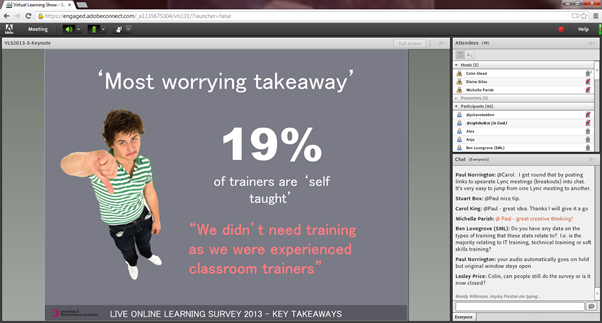I spoke to Colin Steed, who has orchestrated the Virtual Learning Show – a free online conference for the Learning & Development sector. Day one was last week, the second and final day is Thursday 27th June 2013. I wanted to know a bit more about what Colin commented on in his keynote opening, what he learnt from day one and from the first VLS last year.
One of the key things I wanted Colin to expand upon was the result from a recent survey where 19% of online trainers said that they were self taught. In his keynote Colin had said he found this worrying. “It’s a very big number” he explained. “The reason it’s worrying is that classroom trainers assume that because they’re good they think they can get the same results online. They need new skills and techniques as well as classroom experience. I speak to people in companies who say ‘why do I need to get trained if I’ve been training for 25 years?’ or ‘why can’t I read it in a book?’ A great analogy I have for this is about driving a car or riding a motorbike – yes you can read a book, but learning and practising in a live environment is key.”
Colin expanded on the issue of experienced classroom trainers not developing the key skills they need for the live online environment: “The outcome is that learners and managers attend an online session and learners get totally bored. They don’t learn as much and live online learning gets a bad name. The issue is that they are talking into a computer screen and end up feeling like a lecturer or presenter. They think that their two hour topic should last two hours online when really they need to break down into chunks.”
I asked Colin what he thought needed to shift in order for trainers to appreciate the different skills needed in the online environment: “We must get groups of people into a live online session that’s well facilitated to see how and why it’s good. Things like momentum, pace, voice, graphical slides and not lists of bullet points! It’s about getting them working – they suddenly click. Most things can have at least one or two elements online. Experiencing a well facilitated session then encourages them to think how they can use their content online and the software facilities can add to the learning experience.”
Day one of the Virtual Learning Show had a long list of speakers. Colin explained what he had taken away from the sessions. “They were all different, highly qualified speakers. There was the content, but what I learnt from every session is that you can be a different type of presenter. Elaine Giles gave a lot of technical information but showed us. Phil Green is one of the best facilitators. He takes things a little more easily and gets you to think, using pauses. Karen Hyder did a tremendous job to explain the differences between three web conferencing systems. The structured session focused on what we needed to know. That’s another lesson – content should be what is needed to know to do the job and cut out the nice to know. Cindy Huggett is probably the best in the world at presenting online. She used the facilities and the tools of the online conferencing system and it was a master class. Cindy made you work in the intro but it wasn’t obvious – a brilliant presentation and a role model for us all. The big thing about presenting online is that you need to be more approachable to overcome the barrier of the internet and computer screen. Cindy has got the most fantastic personality for online. You could ask any question and she was delighted to answer. Four sessions in all; brilliant but all different.”
Focusing on learning, I asked Colin to compare last year’s first VLS with this year. He commented: “There were new speakers, different in content and style. The first year there was Roger Courville, very flamboyant, friendly and approachable. Bob Mosher, a master at getting people to talk and very passionate. All the speakers last year and this year were passionate. You’ve got to be. In December we will have new speakers, including Clive Shepherd – a master at storytelling.”
With the sun straining to get through the clouds today, December doesn’t feel too far away. However I’m determined to focus on summer and the second VLS day. Colin was excited too, saying that “Julie Dirksen is a heroine for design and how we use the brain to learn. Her book Design For How People Learn is a master class – things that are a little bit complicated she makes easy to understand. For the first time we have a case study. Claire Line from Hogan Lovells is going to tell us about how she took a large company from not doing virtual classes to a global virtual classroom.”
Finishing off by talking about the challenge of an online conference, Colin explained, “with the right content, speakers and breaks, it works. The feedback has been tremendous and the numbers of attendees are growing. I’m absolutely delighted and very surprised at the delegates from all over the world. About a third are overseas. A lot are from the States and Australia. Bear in mind the time zones – Australia is 12 hours ahead! There are also lots of Canadians and Europeans. Also interesting is that about 95% of the marketing has been done through Twitter – people kindly blogging and re-tweeting. It shows the power and reach of Twitter – you can do some good things!”



One Comment
Comments are closed.